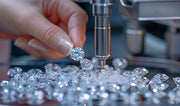
Lab-grown diamonds are transforming the entire fashion industry by blending science and elegance together. These stones resemble natural diamonds, created in a lab with carefully controlled conditions and systems. Lab-grown diamonds are now very popular in this fashion-approving world; these natural-like stones are used in luxury jewellery like diamond rings for women, bridal diamond ring sets, engagement diamond rings, and even cluster diamond earrings. For those who value brilliance, richness, and sustainability, lab-grown diamonds have become their everyday choice.
But the question now arises is- how exactly are these created? Let’s explore.
The Concept of Lab-Grown Diamonds
Lab-grown diamonds are an imitation of mined diamonds- chemically, physically, and visually. Both diamonds are made through a process where a crystalline structure is formed due to pure carbon. The only difference between these two is that one is formed under the surface of Earth, which takes over billions of years, and the other is formed in the lab under the same conditions, but in a matter of weeks.
Because of this advanced technology, our brand Luxuré by I&I offers sustainable luxury jewellery, giving you varied options and alternatives for engagement diamond rings or bridal diamond ring sets without making any compromise in quality and richness. With their beauty, lab-grown diamonds are kinder to our environment and don’t create any harm to our planet as mined diamonds do. This makes these luxury jewellery pieces the perfect choice for those who care about our planet and value ethics.

Key Methods Used to Create Lab-Grown Diamonds
-
CVD (Chemical Vapour Deposition)
This process begins with a thin slice of diamond, which is also known as a seed. This seed is placed inside a closed chamber and then filled with carbon-rich gases such as methane, and then heated to extremely high temperatures. The carbon-rich gases, while heated at high temperatures, break down, which leads the carbon atoms attached to the seed to form crystal layers, forming a large diamond crystal over time.
This process is used to make high-quality diamonds under the same conditions as natural ones. CVD- grown diamonds are used for making fine luxury jewellery like engagement diamond rings, bridal diamond ring sets, and also diamond rings for women, having the perfect balance of beauty and tradition.
-
HPHT (High Pressure High Temperature)
This process of making lab-grown diamonds is a perfect replication of the natural conditions as found beneath the Earth. A pure carbon is placed along with a slice of diamond (seed) inside a container. Then the object goes through high pressure and high temperature, which leads the carbon to form crystals around the seed.
HPHT diamonds are known for their durability and shine. Many jewellery makers use these diamonds for cluster diamond earrings or for diamond rings for women. As the process replicates the natural process so closely, diamonds produced through this process have the same durability and sparkle.
Conclusion
Lab-grown diamonds are a blend of tradition, modernity and science. The process of making these diamonds is similar to that of natural and mined diamonds. These two processes, CVD and HPHT, not only give shiny and sparkly stones but also give the same durability and beauty. Whether you are looking for engagement diamond rings, bridal diamond ring sets, or stylish cluster diamond earrings, lab-grown diamonds offer a varied range of luxury jewellery sets according to your choice.
FAQs
-
How is a lab-grown diamond created?
A small piece of diamond or seed is placed in a closed chamber where extreme heat and pure carbon gas form a diamond.
-
How much is a 1-carat lab diamond worth?
A 1-carat lab-grown diamond is usually cheaper than a natural one.
-
How long does it take to grow a diamond in a lab?
It normally takes a week to grow a diamond in a lab.
-
How much does it actually cost to make a lab diamond?
It costs less than a natural diamond. But includes the charges of labour and technology.









